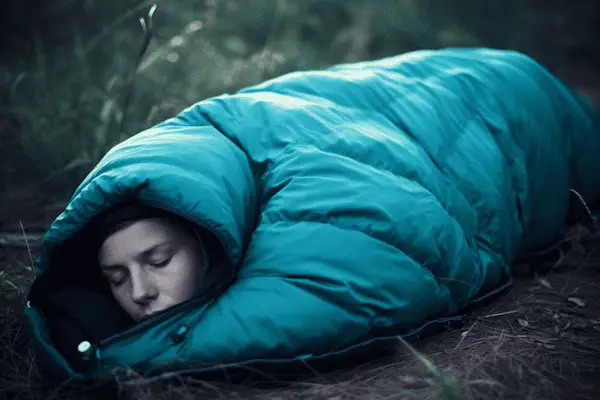If you’re loading up your backpack for the first time, you might be wondering how to attach a sleeping bag to a backpack. As luck would have it, there are a bunch of ways you can do this.
Here are 7 ways to attach a sleeping bag to a backpack:
- External Attachment Loops
- Compression Straps
- Dedicated Sleeping Bag Compartments
- Daisy Chains
- Bungee Cords
- Aftermarket Accessory Straps
- DIY Fabric Loops

1. The Handy Utility of External Attachment Loops
External attachment loops are like the unsung heroes of the backpacking world. They’re often overlooked, but they provide a practical solution for attaching additional gear, such as sleeping bags, to your backpack. These loops, found on the outside of many backpacks, are usually made from durable webbing material, designed to withstand the elements and the rigors of the great outdoors.
Think of these loops like the hooks on a pegboard – a place to hang or attach whatever you can’t fit inside your pack or would rather have quick access to. To attach something like a sleeping bag, you can use a variety of methods. One common method is to use a carabiner or ‘biner for short. This is a kind of clip that can be quickly and easily hooked onto the loop and your sleeping bag.
Another method is to use ropes or straps. You can thread these through the loops and around your sleeping bag, creating a secure connection that keeps your bag in place even during rigorous movement. The beauty of using these loops is the ease of access they provide. Need to set up camp quickly? Just unhook or unstrap your sleeping bag, and you’re good to go.
2. Harnessing the Power of Compression Straps
Say hello to compression straps, your new best friends in the world of backpacking! Found on many backpacks, these strong and adjustable straps can be real game changers when it comes to attaching your sleeping bag or other equipment.
Here’s the lowdown: compression straps are usually positioned at the sides or bottom of a backpack. When it comes to sleeping bags, most hikers love compression straps. You just roll your sleeping bag up tightly, pop it into a waterproof sack for good measure (no one likes a wet sleeping bag!), and secure it snugly under these straps.
And guess what? These straps are adjustable, which means you can tighten them to secure your bag and prevent it from shifting or dropping. But that’s not all. They also help compress your bag and other gear, reducing their volume and making your pack more streamlined. This is great news when you’re navigating through narrow trails or dense undergrowth.
3. The Charm of Dedicated Sleeping Bag Compartments
Ever wished for a specific pocket for your sleeping bag in your backpack? Say hello to dedicated sleeping bag compartments! These handy features offer a unique solution for your sleeping bag storage needs, making your trekking adventure a whole lot simpler.
Sleeping bag compartments are found in many hiking or camping-oriented backpacks, generally at the bottom. They’re designed to snugly fit a compact, rolled-up sleeping bag, keeping it secure and easily accessible. Instead of rummaging through your pack, you just unzip the dedicated compartment, pull out your sleeping bag, and you’re ready to turn in for the night.
Do remember, though, not all sleeping bags are the same size, so make sure yours fits comfortably in the compartment. If it doesn’t, no worries! Just use one of the other 6 methods for attaching a sleeping bag to your backpack. But when it works, a dedicated sleeping bag compartment can be a real convenience, offering a simple, efficient, and neat solution for carrying your sleeping bag on the trail.
4. Daisy Chains: Backpacking’s Versatile Accessory
Daisy chains are a series of loops created in the webbing on the front or sides of backpacks. But they’re not there just for decoration – they serve a pretty cool purpose!
Daisy chains work like a charm for attaching your sleeping bag or other gear. Here’s how: You can use straps or carabiners to clip your sleeping bag onto the daisy chain loops. This not only secures your sleeping bag but also leaves it easily accessible for when you decide to set up camp.
What’s great about these chains is their versatility. You can hang almost anything from them – water bottles, shoes, or even that muddy pair of socks you’d rather keep outside your pack. And the best part? It’s quick and easy to attach and remove items, which means less hassle for you on the trail.
5. Bungee Cords: A Flexible Solution for Backpacking
When it comes to versatility in the backpacking world, bungee cords are a real winner. Not every backpack comes with all the bells and whistles you’d like, and that’s where these handy cords come into play.
Bungee cords, or shock cords as they’re sometimes called, are strong, elasticated ropes with hooks on either end. They’re like the Swiss Army knife of the camping world – super useful in a whole range of scenarios. One of those is attaching your sleeping bag to your backpack.

All you need to do is loop the bungee cord through your backpack’s existing structure, say through the carry handle or any available loops, and then around your sleeping bag. The elasticity of the cord ensures a tight grip, and the hooks make it easy to fasten and release.
And one of the best things about bungee cords? Their adjustability. You can tighten or loosen them as needed to securely hold your sleeping bag or other gear. They’re like a customizable gear attachment system for your backpack.
6. Amp Up Your Backpack with Aftermarket Accessory Straps
Who said backpacks are only about what you get from the manufacturer? With aftermarket accessory straps, you can up your backpacking game and make carrying your sleeping bag a breeze.
These straps are like a magic trick for your backpack – they allow you to attach all kinds of gear, including your sleeping bag, to the outside of your pack. They come in a range of lengths, materials, and styles, with features like quick-release buckles, which can make accessing your sleeping bag super easy and quick.
To use them, all you need to do is strap them around your rolled-up sleeping bag and then attach the straps to your backpack. Most backpacks have loops, handles, or other structures you can use to secure the straps so you shouldn’t have any trouble finding a place to attach them.
7. DIY Fabric Loops: Customizing Your Backpack
Did you know you can enhance your backpack’s functionality by sewing on some DIY fabric loops? It’s a fantastic solution if your backpack doesn’t come with enough attachment points or if you simply like to customize your gear.
Creating your own fabric loops is a relatively easy process. You just need some durable fabric or webbing, a needle, and some heavy-duty thread. Position your loops where they best suit your needs, stitch them on securely, and there you have it – additional points to attach your sleeping bag or other items!

These loops can be used with carabiners or straps to securely hold your sleeping bag. The real beauty of this method is the flexibility it offers. You can position the loops where you find them most convenient – maybe you want your sleeping bag at the bottom of your pack, or perhaps on the side. With DIY loops, the choice is yours.
Just keep in mind that balance is crucial when attaching your sleeping bag to your backpack. An unbalanced pack can lead to discomfort on your adventure. Also, remember to reinforce your stitches to ensure the loops are strong enough to carry the weight of your sleeping bag. So, if you’re feeling a bit crafty before your next outdoor trip, why not give this DIY hack a shot?
